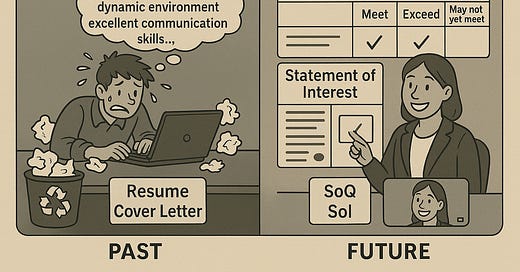We've revolutionized nearly every aspect of recruiting yet we still default to the same tired formula: Please submit your resume along with a cover letter.
In the age of ChatGPT, this approach has become not just inefficient but almost comically obsolete. Large language models now craft eloquent cover letters in seconds. This technological shift has rendered traditional cover letters as useless resume enhancements and inauthentic expressions of interest.
Organizations invest millions in sophisticated talent acquisition strategies and software, but continue to demand candidates apply in a format that hasn't meaningfully evolved since the 1980s. If I were in charge, I’d ditch the traditional cover letter. Instead, I’d ask for a similar – but meaningfully different – pair of letters: A Statement of Qualifications (SoQ) and Statement of Interest (SoI).
SoQ + SoI
This two-pronged approach respects both the employer's need to screen efficiently and the candidate's desire for meaningful engagement:
Statement of Qualifications (SoQ)
When applying for a job, candidates should be asked to submit a Statement of Qualifications (SoQ). It’s a simple, structured list where candidates take every bullet point in the job qualifications section of a job description and copy/paste each of them into one of three categories:
May not yet meet
Meet
Exceed
That’s it. This structured format limits generic AI outputs while encouraging honest self-assessment. The transparency required to acknowledge skills gaps creates a more honest starting point.
Statement of Interest (SoI)
Along with the SoQ, candidates should submit a Statement of Interest (SoI) – a short expression of their interest in the position. I’d invite candidates to submit this in either written (one page) or video (three minutes) format.
The SoI is what a cover letter should always have been instead of an ill-defined mishmash of resume-explanation and generic love letter. The Statement of Interest is an explicitly forward-looking concept: Rather than talk about who they are and what they have done, it asks candidates to focus on what they want to do.
The video option creates a barrier to complete AI automation, requiring candidates to personally engage with the opportunity and creating meaningful signals about genuine interest.
Why This Approach Works
The combination of the SoQ and SoI has a handful of benefits:
Acknowledges technological reality: It adapts to the AI-augmented world we actually live in and avoids the hack cover letters that nobody is reading anymore.
Creates meaningful friction at the right point: It introduces just enough effort at the right moment to require genuine interest without burdening any serious candidates.
Provides more valuable information: Organizations get structured data (particularly the SoQ) that’s far more actionable at the screening stage.
Enhances candidate experience: It signals that your organization values innovation and respects candidates' time.
Leverages both past experience and future potential: It ensures insight into both what candidates have done and what they're excited to do next.
Implementation Notes
Want to pull the trigger on this? Here’s what I recommend:
Pilot this approach: Rather than revamping your entire hiring process at once, pick one critical role and focus on successful implementation.
Measure nontraditional metrics: Such as quality-to-quantity ratio of candidates, feedback on the application experience, and hiring manager satisfaction with the information received.
Avoid common pitfalls: Don't make job descriptions overly complex, make sure you ensure consistent requirements across formats, and maintain transparency about your process.
What's fascinating is how this approach often reveals deeper insights about both the role and your organization's hiring philosophy. You may find the process of reimagining applications leads to greater clarity about what you're truly looking for in candidates.
The way we engage with candidates matters more than we think. Performance management starts at the job marketing and application stage, not just once someone is on the team! By moving beyond industrial-era templates and acknowledging today's AI-transformed reality, we can dramatically improve how organizations and candidates find each other. The future of work demands nothing less.
That's it for this edition - please reach out if I can be at all helpful.
Be compassionate and intentional.






YES!!! I'm not hiring at the moment but as soon as I have openings I will 100% use this approach. Thank you!!!